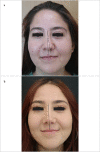Functional and Aesthetic Outcomes of Asymmetric Dorsal Preservation for Correction of I-Shaped Crooked Nose Deformity
- PMID: 37583976
- PMCID: PMC10424583
- DOI: 10.4274/tao.2023.2022-12-1
Functional and Aesthetic Outcomes of Asymmetric Dorsal Preservation for Correction of I-Shaped Crooked Nose Deformity
Abstract
Objective: The study was designed to evaluate the effectiveness of the asymmetric dorsal preservation technique for correcting I-shaped crooked nose deformity (CND).
Methods: Patients with I-shaped CND who underwent asymmetric dorsal preservation in the period from September 2020 to September 2021 were included in this retrospective study. The Rhinomanometry and Standardized Cosmesis and Health Nasal Outcomes Survey (SCHNOS) was used to assess the outcomes. Deviation angle (DA) measurements were used to evaluate the degree of crookedness. The results were recorded both preoperatively and 12 months postoperatively.
Results: Twenty-three patients were included in the study. Total nasal airflow and long-side nasal airflow were significantly higher 12 months postoperatively (p=0.001 each). Total nasal resistance, long-side nasal resistance, SCHNOS scores and DA measurements were significantly lower 12 months postoperatively (p<0.001 each).
Conclusion: Asymmetric dorsal preservation is a successful alternative technique for correcting I-shaped CND and achieving optimal aesthetic and functional outcomes.
Keywords: Nose; facial asymmetry; rhinomanometry; rhinoplasty.
©Copyright 2023 by Turkish Otorhinolaryngology-Head and Neck Surgery Society / Turkish Archives of Otorhinolaryngology is published by Galenos Publishing House.
Conflict of interest statement
Conflict of Interest: The authors have no conflicts of interest to declare.
Figures



References
-
- Stepnick D, Guyuron B. Surgical treatment of the crooked nose. Clin Plast Surg. 2010:;37:313–25. - PubMed
-
- Demir UL. A novel approach to crooked nose in rhinoplasty: asymmetric level osteotomy combined with unilateral spreader graft. J Craniofac Surg. 2019;30:1512–5. - PubMed
-
- Saban Y, Daniel RK, Polselli R, Trapasso M, Palhazi P. Dorsal preservation: the push down technique reassessed. Aesthet Surg J. 2018;38:117–31. - PubMed
-
- Lothrop OA. An operation for correcting the aquiline nasal deformity; the use of new instrument; report of a case. Boston Med Surg J. 1914;170:835–7.
-
- Cottle MH, Loring RM. Corrective surgery of the external nasal pyramid and the nasal septum for restoration of normal physiology. Ill Med J. 1946;90:119–35. - PubMed
LinkOut - more resources
Full Text Sources
